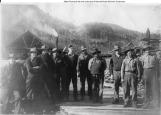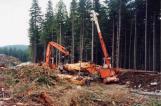15
The 1940s and 1950sSince the mid 1930's it has been more efficient to bring logs and shake and shingle bolts to mills on the Fraser River with transportation being either by truck or water.
Saw milling (for dimensional, or dressed, lumber) has all but disappeared from Mission. Shake and shingle manufacturing is now the dominant lumber industry in this area.
During the 1940's there were a few new mills started in the Mission area and new names became associated with the lumber industry in Mission. (Watkins, McMahon, Thomas, Braich) Many of their mills are still in local operation. One of the main lumber mill operations started was the Thomas Lumber Company, opened in 1945 by Albert Thomas (because Albert's father was a photographer we have many photos from this family). McMahon Lumber Company opened in 1947. Bill Watkins opened a mill outside of Mission in 1942 and moved it to Mission in 1959.
Shirley Ruddick, a woman of many talents, from cooking camp meals to operating skidders and who helped put this exhibit together was introduced to camp life at a young age. Her husband Bruce Ruddick worked at Stave Lake, for his brother Ken Ruddick (Flo Lake Logging Co.), and for Bob Cameron. Between 1948 and 1952, Bruce joined forces with Ken and they operated under the name of Ruddick Brothers. In 1953, the business name was changed to K&B Logging.
Their business kept a camp at Stave Lake, where the woodsmen would stay out during the workweek. (See videos in this exhibit) Shirley and her children also lived up at camp. She related how, on Monday mornings they would all pile into the Kingfisher boat that would take them up the Stave River and across the Stave Lake to their camp. On a good day, the boat trip would take about one hour. There were usually about 9 men going to work with the family.
Upon arrival, the men would unload everything and Shirley would take her kids to the cookhouse on top of the hill to start making coffee and packing lunches. The camp was on the hillside, and the cookhouse (photo) was actually on a slant, with holes in the floor. This was to let the water drain out after hosing it down for cleaning. From the vantage point of the cookhouse, she could see any visitors that came to the camp. "Visitors" consisted of the Workmen's Compensation Board representative, the forestry people, and the odd fisherman.
Coming home on Fridays meant another boat trip, and sometimes boats would race each other down the lake.
16
K. and B. cookhouse, camp buildings and bunkhouses located at the top of a hill.1950
K. and B. Logging camp on Stave Lake

17
The 1960s-1970sBy the 1970s, logging was a more serious business. You could no longer claim a piece of land, log it and move on to a new area. The government had created rules and regulations governing the logging industry.
Locally, Peter Kokoska was awarded the first licensed Woodlot in BC, number WL0001. Originally (in 1940), Adam Kokoska (Peter's father) had owned a BC Farm lot license that allowed him to log and replant 160 acres. In 1979, the government changed the outline and said that woodlots could be 1000 acres, but farmlots couldn't change from 160 acres.
19
The 1980s- into the 21st centuryThe logging industry continues to play a vital role in Mission's economy. Logging companies still remove the allowed percentage of trees every year, but unlike the old days of logging, they are responsible for the replanting of the timber.
In recent years, the shake and shingle industry has put Mission on the map for having the best red cedar shake and shingles in the world.
In 1990 Mission boasted over fifty mills in its surrounding areas and produced 3,000,000 squares annually, worth approximately $150,000,000 (1990 figures).
Mechanization of the mills has caused a drastic reduction in the need for manpower, and changes to roofing materials have resulted in cheaper products being available and caused the market for shakes to decline. There are also a number of complex political issues surrounding the lumber industry today that are causing many changes to take place and lumber is no longer a primary industry in Mission.
At this time (2003), there are at least twelve mills still operating in the Mission area. Financial figures were not available.

